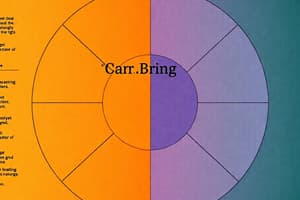Podcast
Questions and Answers
How does extreme conscientiousness relate to curvilinear relationships in personality testing?
How does extreme conscientiousness relate to curvilinear relationships in personality testing?
Extreme conscientiousness can show an inverted-U curve, where optimal performance occurs at around 1 standard deviation above the mean.
What interpersonal problems may arise from personality disorders as highlighted in curvilinear relationships?
What interpersonal problems may arise from personality disorders as highlighted in curvilinear relationships?
Personality disorders can create interpersonal problems, especially when individuals score at extremes on personality traits, affecting social interactions negatively.
Discuss the significance of neuroanatomical correlates in understanding personality disorders.
Discuss the significance of neuroanatomical correlates in understanding personality disorders.
Neuroanatomical correlates provide insights into the biological underpinnings of personality disorders, influencing traits and behaviors associated with such disorders.
What might the implications be of utilizing appropriate personality-test scoring on curvilinear relationships?
What might the implications be of utilizing appropriate personality-test scoring on curvilinear relationships?
How does the concept of an inverted-U curve apply to extreme levels of personality traits?
How does the concept of an inverted-U curve apply to extreme levels of personality traits?
What does curvilinearity in the context of personality traits imply?
What does curvilinearity in the context of personality traits imply?
Personality disorders are considered unrelated to personality traits.
Personality disorders are considered unrelated to personality traits.
What is one possible consequence of having extreme personality traits?
What is one possible consequence of having extreme personality traits?
The ______ curve describes the relationship between extreme levels of personality traits and their effects.
The ______ curve describes the relationship between extreme levels of personality traits and their effects.
Match the following concepts with their explanations:
Match the following concepts with their explanations:
In which type of jobs did Williamson and Carter (2016) find a stronger inverted-U relation with citizenship behavior?
In which type of jobs did Williamson and Carter (2016) find a stronger inverted-U relation with citizenship behavior?
The relationship between citizenship behavior and social demands is linear for jobs with low social demands.
The relationship between citizenship behavior and social demands is linear for jobs with low social demands.
What type of research should be conducted in the future concerning citizenship behavior?
What type of research should be conducted in the future concerning citizenship behavior?
Williamson and Carter (2016) found that jobs with high social demands exhibited a _____ relation with citizenship behavior.
Williamson and Carter (2016) found that jobs with high social demands exhibited a _____ relation with citizenship behavior.
Match the type of job with the relationship regarding citizenship behavior found by Williamson and Carter (2016):
Match the type of job with the relationship regarding citizenship behavior found by Williamson and Carter (2016):
Flashcards are hidden until you start studying
Study Notes
Curvilinear Relationships in Personality Tests
- Curvilinear relationships demonstrate that outcomes peak at specific levels of personality traits, often illustrated by inverted-U curves.
- Optimal performance is generally found at approximately 1 standard deviation above the mean for desirable personality traits.
- Linear relationships exist between levels of desirable outcomes and desirable personality traits, indicating a direct correlation.
- Inverted-U relationships suggest that initially, increased levels of certain traits lead to improved outcomes, but after a certain point, additional traits may not yield further benefits or could be detrimental.
- Proper scoring methods in personality tests are crucial for accurately capturing these relationships and drawing meaningful conclusions.
Personality and Curvilinearity
- Personality traits exhibit a curvilinear relationship, often represented as an inverted U shape.
- This model suggests that there is an optimal level of a trait that varies based on situations and individual differences.
Citizenship Behavior
- Research by Williamson and Carter (2016) indicates that the inverted-U relationship with citizenship behavior is more pronounced in low social demand jobs.
- In high social demand jobs, the relationship is linear, suggesting different dynamics in varying work environments.
Trait-Level Combinations
- Various combinations of personality traits, or “profiles,” can exist independently and may be explored in future research.
- This indicates a need to understand how different traits interact and function together.
Research Directions
- Future research should aim to expand existing personality taxonomies to incorporate new findings.
- Evolutionary scientists are encouraged to utilize simulation techniques to study personality selection rules.
Measurement Challenges
- Testing for curvilinearity within personality assessments presents challenges and may require innovative approaches.
- Understanding the "ideal point" in personality traits could be critical for accurate assessments and applications.
Funding Note
- The findings discussed are based on a study published in "Personality and Individual Differences," highlighting the rigorous investigation of personality traits.
Studying That Suits You
Use AI to generate personalized quizzes and flashcards to suit your learning preferences.




